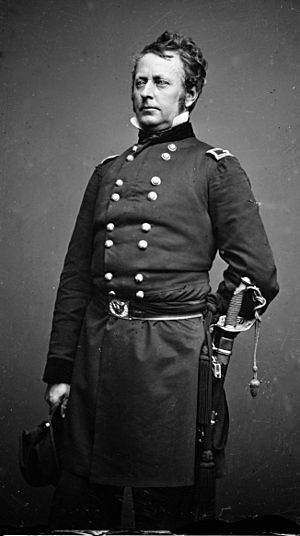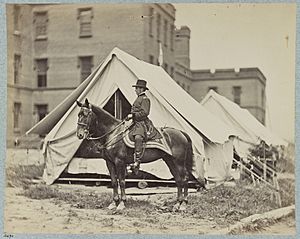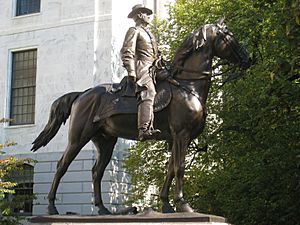Joseph Hooker facts for kids
Quick facts for kids
Joseph Hooker
|
|
|---|---|

Portrait by Mathew Brady or Levin C. Handy
|
|
| Nickname(s) | Fighting Joe |
| Born | November 13, 1814 Hadley, Massachusetts |
| Died | October 31, 1879 (aged 64) Garden City, New York |
| Place of burial |
Spring Grove Cemetery
|
| Allegiance | Union |
| Service/ |
|
| Years of service | 1837–1853, 1861–1868 (USA) 1859–1861 (California) |
| Rank | |
| Commands held | I Corps Army of the Potomac XX Corps Department of the East |
| Battles/wars | Seminole Wars Mexican-American War American Civil War |
| Signature | |
Joseph Hooker (November 13, 1814 – October 31, 1879) was a career United States Army officer, achieving the rank of major general in the Union Army during the American Civil War. Although he served throughout the war, usually with distinction, Hooker is best remembered for his stunning defeat by Confederate General Robert E. Lee at the Battle of Chancellorsville in 1863.
Early years
Hooker was born in Hadley, Massachusetts, the grandson of a captain in the American Revolutionary War. He was of entirely English ancestry, all of whom had been in New England since the early 1600s. His initial schooling was at the local Hopkins Academy. He graduated from the United States Military Academy in 1837, ranked 29th out of a class of 50, and was commissioned a second lieutenant in the 1st U.S. Artillery. His initial assignment was in Florida fighting in the second of the Seminole Wars. He served in the Mexican–American War in staff positions in the campaigns of both Zachary Taylor and Winfield Scott. He received brevet promotions for his staff leadership and gallantry in three battles: Monterrey (to captain), National Bridge (major), and Chapultepec (lieutenant colonel). His future Army reputation as a ladies' man began in Mexico, where local women referred to him as the "Handsome Captain".
After the Mexican–American War (which ended in 1848), he served as an assistant adjutant general of the Pacific Division, but resigned his commission in 1853; his military reputation had been damaged when he testified against his former commander, General Scott, in the court-martial for insubordination of Gideon Johnson Pillow. Hooker struggled with the tedium of peacetime life and ran unsuccessfully for election to represent the region in the California legislature. He was obviously unhappy and unsuccessful in his civilian pursuits because, in 1858, he wrote to Secretary of War John B. Floyd to request that his name "be presented to the president Buchanan as a candidate for a lieutenant colonelcy", but nothing came of his request. From 1859 to 1861, he held a commission as a colonel in the California militia.
Civil War
At the start of the Civil War in 1861, Hooker requested a commission, but his first application was rejected, possibly because of the lingering resentment harbored by Winfield Scott, general-in-chief of the Army. He had to borrow money to make the trip east from California. After he witnessed the Union Army defeat at the First Battle of Bull Run, he wrote a letter to President Abraham Lincoln that complained of military mismanagement, promoted his own qualifications, and again requested a commission. He was appointed, in August 1861, as brigadier general of volunteers to rank from May 17. He commanded a brigade and then division around Washington, D.C., as part of the effort to organize and train the new Army of the Potomac, under Maj. Gen. George B. McClellan.
Hooker planned an audacious campaign against Robert E. Lee, but his Army was defeated by the Confederate Army at the Battle of Chancellorsville. Casualties were heavy on both sides (approximately 17,000 of the Union's 117,000 troops, and 13,000 of the Confederate's 60,000 troops).
Lincoln kept Hooker in command, but when General Halleck and Lincoln declined Hooker's request for troops from Harpers Ferry to reinforce his army while in pursuit of Lee's advance toward Pennsylvania, Hooker resigned his command. George G. Meade was appointed to the command of the Army of the Potomac on June 28, 1863, three days before Gettysburg, and was allowed to take the troops from Harpers Ferry.
Hooker returned to combat in November, leading two corps from the Army of the Potomac to help relieve the besieged Union Army at Chattanooga, Tennessee, and achieving an important victory at the Battle of Lookout Mountain during the Chattanooga Campaign. He continued in the Western Theater under Maj. Gen. William T. Sherman.
Final years
After the war, Hooker led Lincoln's funeral procession in Springfield on May 4, 1865. He served in command of the Department of the East and Department of the Lakes following the war. His later life was marred by poor health and he was partially paralyzed by a stroke. He was mustered out of the volunteer service on September 1, 1866, and retired from the U.S. Army on October 15, 1868, with the regular army rank of major general. He died on October 31, 1879 while on a visit to Garden City, New York, and is buried in Spring Grove Cemetery, Cincinnati, Ohio, his wife's home town.
There is an equestrian statue of General Hooker outside the Massachusetts State House in Boston, and Hooker County in Nebraska is named for him.
Images for kids
-
Major General Joseph Hooker, 1862. From the Liljenquist Family Collection of Civil War Photographs, Prints and Photographs Division, Library of Congress. Photograph by Mathew Brady
See also
 In Spanish: Joseph Hooker (militar) para niños
In Spanish: Joseph Hooker (militar) para niños












